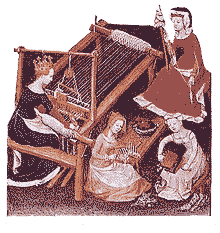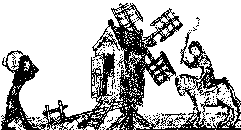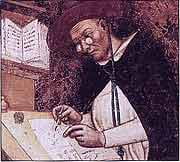Paper
Paper was invented by the Chinese prior to the first century AD. Water-suspended vegetable fibers felted onto a screen were dried using heat. The most common source of such fiber was the bark of the paper mulberry tree. [Gies & Gies 1995 p 182] By the third century AD paper-making and usage had spread beyond China. Using paper for toilet purposes is recorded in China in the sixth century, AD. It was made from rice straw and was cheap and soft. [Gies & Gies 1995 p 95-6] Tradition holds that paper came into the Islamic countries when the Arabs conquered Samarkand in 753 AD. By the year 793 AD there was a paper factory in Baghdad and by 1000 AD paper was in general use throughout the Islamic world, not only for books, but as wrapping material and napkins as well. By 950 AD water power was used in the fiber pounding process in Baghdad. [Gies & Gies 1995 p 97][Mokyr 1990 p 41]
Paper entered Europe through Islamic Spain and Sicily in the tenth century. The first written reference to it seems to be in the pseudonymous Theophilus Presbyter’s “The Art of the Painter” (first half of the twelfth century) where he recommends “Byzantine parchment”, most likely meaning paper. [Gies & Gies 1995 p 127] However, paper came slowly to Christian Europe and it was not until the 13th century that its use became at all widespread and production begun. Typically the west almost immediately began to use water power to process the pulp. [Mokyr 1990 p 41]
The production of paper was done in three steps. First, rags (mostly linen) were shredded and soaked in a “rotting room” and were finally beaten into a pulp of individual fibers. The second step was moving the pulp-laden liquid to settling tanks with mesh screens at the bottom. The fibers settled into a mat which eventually was taken out, the water removed by squeezing, and the sheets hung to dry. In the third step the sheets were rubbed smooth with a stone and then sized by soaking in a vat of gelatin and alum and again dried. As the primary use for paper in Europe was for writing, this last step was necessary to enable the surface to take and hold ink. [Gies & Gies 1995 p 182]
This page is maintained by Paul J. Gans. Please address all comments to him.
Page last modified: Tuesday, 08-Oct-2002 19:44:18 EDT
The Horizontal Loom
The horizontal loom appeared in Europe in the 11th century. The first reference to it seems to be in the Talmudic commentaries of Rashi, who lived in Troyes. He indicates that such a loom was being used by professional weavers. [Mokyr 1990 p 52] By the 12th century it had been mechanized. [Gies & Gies 1995, p 119] This loom was probably adapted from a Chinese version already extant. Old looms had been vertical. The new one was horizontal and was operated by foot-treadles. Instead of weaving the heddle bar through the warp threads as had been done on the vertical loom, now the weaver had only to pump his treadles and every other warp thread rose up above the work. He then passed the heddle bar through the opening. On the next pump of the treadles, the other set of warp threads rose.
Along with the new loom came a new boat-shaped shuttle which contained a bobbin wound with thread. The combination allowed very efficient weaving.
 To the left is a picture of a horizontal loom from about 1250 AD. The perspective is peculiar; the loom is actually parallel to the floor. The weaver works the two pedals to lift alternate pairs of threads. The shuttle with its bobbin can barely be seen in this example. The original illustration is in a manuscript at Trinity College, Cambridge. This copy is taken from Gies & Gies 1995, p 119
To the left is a picture of a horizontal loom from about 1250 AD. The perspective is peculiar; the loom is actually parallel to the floor. The weaver works the two pedals to lift alternate pairs of threads. The shuttle with its bobbin can barely be seen in this example. The original illustration is in a manuscript at Trinity College, Cambridge. This copy is taken from Gies & Gies 1995, p 119
The weaver was usually the male head of a household. His wife spun yarn for the loom. [Gies & Gies 1995, p 119]
 On the right is a 15th century image from a copy of Boccaccio’s De Claris Mulieribus. By this time women were also weavers. In addition to the loom (in which the foot pedals can clearly be seen) three other women illustrate other steps in the creation of cloth. The woman at the upper right is using a distaff, a simple device that spins strands of wool into thread. The two women at the bottom right are combing and carding the wool. This removes tangles and aligns the strands so that they can be spun into thread.
On the right is a 15th century image from a copy of Boccaccio’s De Claris Mulieribus. By this time women were also weavers. In addition to the loom (in which the foot pedals can clearly be seen) three other women illustrate other steps in the creation of cloth. The woman at the upper right is using a distaff, a simple device that spins strands of wool into thread. The two women at the bottom right are combing and carding the wool. This removes tangles and aligns the strands so that they can be spun into thread.
As can be seen in both illustrations, the warp threads are rolled around a cylinder of wood at the far end of the loom. They are unrolled as needed. Finished cloth is gathered at the front of the loom. The foot treadles normally raise every other warp thread, but that can be changed by the weaver. The shuttle threads are wound on a bobbin that is attached to the shuttle. The color of these threads can easily be changed to vary the pattern.
This page is maintained by Paul J. Gans. Please address all comments to him.
Page last modified: Tuesday, 08-Oct-2002 23:44:18 EDT
Windmills
There are two basic kinds of windmills. One kind, the horizontal mill, has sails that revolve in a horizontal plane around a vertical axis. Such mills are known from the 7th century AD in the region around modern Iran and Afganistan. [Gimpel 1976 p. 24]
It is relatively easy to attach a grindstone directly to the rotating vertical axis (made of wood). On the other hand, typical rotational speeds of such mills (dictated by the wind) are unsuitable for efficient grinding of grain.
 The other kind of windmill is the vertical or post mill, seen to the right in a picture reproduced from Gimpel. [Gimpel 1976 p 25] Here the sails are vertical, revolving around a horizontal axle. The other end of this axle is attached to a wooden gear which in turn is attached to gear on a separate vertical axle to which the millstone is attached. The gear ratio is set to provide a reasonable grinding speed in a typical wind.
The other kind of windmill is the vertical or post mill, seen to the right in a picture reproduced from Gimpel. [Gimpel 1976 p 25] Here the sails are vertical, revolving around a horizontal axle. The other end of this axle is attached to a wooden gear which in turn is attached to gear on a separate vertical axle to which the millstone is attached. The gear ratio is set to provide a reasonable grinding speed in a typical wind.
The illustration shows such a mill with its vertical sails and a ladder up to the mill itself. If one looks closely one can see the vertical post supporting the mill. The mill can be turned on this post by means of the arm seen to the left near the foot of the peasant bringing grain to the mill. The arm looks here like a small bit of a fence.
The post mill seems to be a purely European invention developed independently of the horizontal mill. While the first surviving mention of one comes from Yorkshire in England in 1185, by 1195 they were sufficiently common that the Pope levied a tithe on them. The post mill was introduced to the Middle East by members of the Third Crusade. [Mokyr 1990 p 44]
The post mill suffers a large disadvantage if it cannot face the wind. To overcome this, the entire mill housing was raised from the ground and made mobile, rotating on a vertical axis. It was light enough to be easily turned by one man. In this way it could be kept turned into the wind at all times. The post mill could generate roughly 2 to 8 horsepower (1 1/2 to 6 kilowatts). [Usher 1954 p 335]
A later development saw larger, permanent mills with rotatable tops. A second sail (a large fin) projected out the back of such mills, automatically keeping them pointed into the wind.
This page is maintained by Paul J. Gans. Please address all comments to him.
Page last modified: Tuesday, 08-Oct-2002 19:44:18 EDT
Compass
The compass was a Chinese invention. There seems to be a reference to a south-pointing spoon in a manuscript of the Han dynasty written in 83 AD. Another reference of the same period states that the jade collectors of Cheng carried a “south pointer” with them so that they would not lose their way. [Gies & Gies 1995 p 94]
Magnetized needles used as direction pointers are attested to in the 8th century AD in China, and between 850 and 1050 they seem to have become common as navigational devices on ships. [Gies & Gies 1995 p 94] White dates such use a bit later, citing dates of 1089-93 and 1116 for mention of magnetized needles being used for geomancy and 1119 and 1122 for use as a mariner’s compass. [White 1962 p 132]
Knowledge of the compass as a directional device came to Western Europe probably sometime in the 12th century. It is essentially certain that it was knowledge of the Chinese compass that was transmitted to Western Europe. The assumed path is by the overland Silk Road and not by sea on the “standard” trading route from China to India to Arab and Egyptian ports. This assumption is made because the Arabs seem to have learned of the compass from the Europeans.
The first mention of the directional compass (as opposed to magnets themselves) occurs in Alexander Neckam’s De naturis rerum (On the Natures of Things), probably written in Paris in 1190. [Gies & Gies 1995 p 157] It is noted that Neckham’s book was widely read by the end of the century, and that by about 1218 Jacques de Vitry considered the compass as a necessity for maritime navigation. By 1225 it was in use in Iceland. [White 1962 p 132]
It is reasonable to assume that the actual date of the introduction of the compass to Europe predates Neckham’s note of it by a number of years. That explains the seemingly “rapid” adoption of it as noted by contemporary writers.
The first Moslem mention of the compass occurs in a Persian story of 1232-3. The first Arabic mention occurs in 1242. White notes that the Arabic word for compass is al-konbas, a further indication of transmission from the west. [White 1962 p 132]
This page is maintained by Paul J. Gans. Please address all comments to him.
Page last modified: Tuesday, 08-Oct-2002 19:44:16 EDT
Spectacles
Spectacles seem to have been invented in Florence in 1285 or a few years later. These were convex lenses, of help only to the far-sighted. Concave lenses of use to the near-sighted were not developed prior to the 16th century. [Cipolla 1994 p 145] The evidence for this, as noted by Carlo Cipolla, lies in a sermon given in Florence in 1306 by Father Giordano de Pisa:
“It is not twenty years since there was discovered the art of making spectacles which help you see well, and which is one of the best and most necessary in the world. I myself saw the man who discovered and practiced it and I talked with him.” [Cipolla 1994 p 145]

This page is maintained by Paul J. Gans. Please address all comments to him.
Page last modified: Tuesday, 08-Oct-2002 23:44:18 EDT
Cannon
A cannon is a large hollow tube designed to use gunpowder to hurl an object at a target. Though there is dispute over the earliest mention of cannon, there is an undoubted reference to their use in the siege of Metz in 1324 [De Vries 1992 p 144] Only slightly later is another reference in a surviving Florentine document of 1326 referring to “pilas seu palloctas ferreas et canones de mettallo“, indicating a bronze cannon firing iron balls. [Cipolla 1965 p 21] A definite reference to cannon occurs that same year in a manuscript of Walter de Milemete’s. A surviving piece corresponding to de Milemete’s illustration exists at the Statens Historiska Mueseum of Stockholm. [Cipolla 1965 p 21]
By 1350 Petrarch wrote “these instruments which discharge balls of metal with most tremendous noise and flashes of fire…were a few years ago very rare and were viewed with greatest astonishment and admiration, but now they are become as common and familiar as any other kinds of arms.” [quoted from Cipolla 1965 p 22]
The primary use of early cannon were as bombards to knock down the walls of besieged towns and castles. The earliest success at this came in 1377 at the siege of Odruik when cannon firing 91 kg (200 pound) balls breached the walls of the castle. [De Vries 1992 p 145]
Cannon underwent rapid evolution in both size and construction. They quickly became large and almost as quickly became small, evolving into hand weapons as well.
This page is maintained by Paul J. Gans. Please address all comments to him.
Page last modified: Tuesday, 08-Oct-2002 19:44:16 EDT
Sources: Taken verbatim on 6 January 2015 from the following archived copies of pages from Professor Paul J. Gans’s website, “The Medieval Technology Pages” (the website itself was no longer accessible):
Paper: https://web.archive.org/web/20051110162251/http://scholar.chem.nyu.edu/tekpages/paper.html
Horizontal loom: https://web.archive.org/web/20150904045102/http://scholar.chem.nyu.edu/tekpages/loom.html
Windmills: https://web.archive.org/web/20051228060848/http://scholar.chem.nyu.edu/tekpages/windmills.html
Compass: https://web.archive.org/web/20060108103804/http://scholar.chem.nyu.edu/tekpages/compass.html
Spectacles: https://web.archive.org/web/20151016123829/http://scholar.chem.nyu.edu/tekpages/spectacles.html
Cannon: https://web.archive.org/web/20051110161823/http://scholar.chem.nyu.edu/tekpages/cannon.html
The following copyright statement appears at the foot of each of the above archived pages:
This text is copyright (©) by its author. If no author is explicitly listed, the author is Paul J. Gans. In addition any included original images and the specific electronic form and design of this material are copyright (©) Paul J. Gans, 1997-2002. Permission is granted by the copyright owners to copy the text and to print out copies for personal or educational use provided that the copyright owners are mentioned as such and all included attributions, including the author’s name, are retained. No permission is granted for commercial use of any of this material without the express written consent of the copyright owners.
You can find archived copies of all the pages from Professor Gans’s former website at the following URL:
https://web.archive.org/web/*/http://scholar.chem.nyu.edu/tekpages/*
You can also find a copy of Professor Gans’s original subject index at the following URL:
https://web.archive.org/web/20180904135153/http://scholar.chem.nyu.edu:80/tekpages/Subjects.html